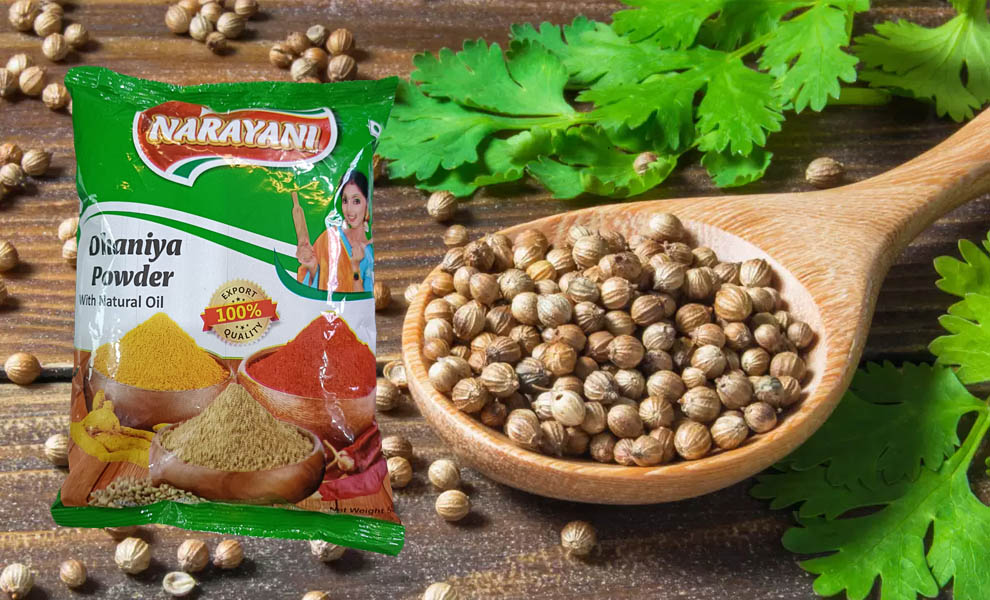
Dhaniya powder, also known as Narayani Coriander Powder, is a popular spice used in various cuisines around the world. It is made by grinding dried coriander seeds into a fine powder. Here’s a comprehensive guide to manufacturing Dhaniya Powder (Coriander Powder) in a commercial setting:
1. Raw Material Selection and Procurement:
Source Quality Coriander Seeds: Purchase high-quality coriander seeds from reliable suppliers. Coriander seeds should be clean and free from contaminants.
Supplier Management: Establish relationships with trusted suppliers to ensure a consistent supply of quality seeds.
2. Cleaning and Preparation:
Cleaning: Clean the coriander seeds to remove any foreign matter such as dirt, stones, and damaged seeds. This is typically done using industrial seed cleaners or air separators.
Optional Sorting: For higher quality, seeds may be sorted based on size and color.
3. Roasting:
Purpose: Roasting coriander seeds enhances their flavor and aroma. It also helps in releasing essential oils, which contributes to the taste and fragrance of the powder.
Roasting Methods:
- Dry Roasting: Place the cleaned coriander seeds in a dry, hot pan or roaster. Heat them over medium heat, stirring frequently to ensure even roasting. The seeds are roasted until they turn slightly darker and release a nutty aroma.
- Industrial Roasters: In large-scale operations, industrial roasting machines can be used to roast coriander seeds uniformly and efficiently.
Cooling: After roasting, allow the seeds to cool completely to prevent them from becoming too oily during grinding.
4. Grinding:
Milling: Grind the roasted coriander seeds into a fine powder using:
- Hammer Mills: Suitable for breaking down the roasted seeds into smaller particles.
- Pin Mills or Pulverizers: Used to grind the seeds into a fine, consistent powder.
Particle Size Control: Adjust the grinding process to achieve the desired particle size. This may involve using different screens or adjusting the mill settings.
5. Sifting and Classification:
Sifting: Sift the ground coriander powder to remove any coarse particles and ensure uniform texture.
Classification: The powder may be classified into different grades based on fineness and quality.
6. Quality Control:
Testing: Conduct quality control tests to ensure the powder meets safety and quality standards:
- Flavor and Aroma: Sensory evaluation to ensure the powder has the correct flavor and aroma.
- Microbial Testing: Check for contaminants such as bacteria, yeast, and molds.
- Pesticide Residue Testing: Ensure the product is free from harmful pesticide residues.
- Moisture Content: Test for moisture to prevent spoilage and maintain quality.
7. Blending (Optional):
Standardization: If necessary, blend different batches of coriander powder to achieve consistent flavor, color, and aroma.
8. Packaging:
Packaging Materials: Use high-quality, food-grade packaging materials that protect the powder from moisture, light, and air.
Filling: Fill the powder into containers such as bags, pouches, or jars. Ensure the packaging is clean and properly sealed.
Labeling: Label the packages with accurate information, including the product name, ingredient list, nutritional facts, and expiration date.
9. Storage and Distribution:
Storage: Store the packaged coriander powder in a cool, dry place to maintain its freshness and prevent spoilage.
Distribution: Implement an efficient distribution system to deliver the product to retailers or customers while maintaining quality.
10. Compliance and Certification:
Regulatory Compliance: Ensure the manufacturing process adheres to local food safety regulations and standards.
Certifications: Obtain necessary certifications such as ISO, HACCP, or organic certifications if applicable.
11. Continuous Improvement:
Monitoring: Continuously monitor the production process to identify areas for improvement.
Innovation: Stay updated with industry trends and technological advancements to enhance product quality and operational efficiency.
Conclusion
The manufacturing of Dhaniya Powder involves careful processing to ensure the final product is flavorful, aromatic, and of high quality. By following these steps and adhering to quality standards, companies can produce coriander powder that meets customer expectations and regulatory requirements.


